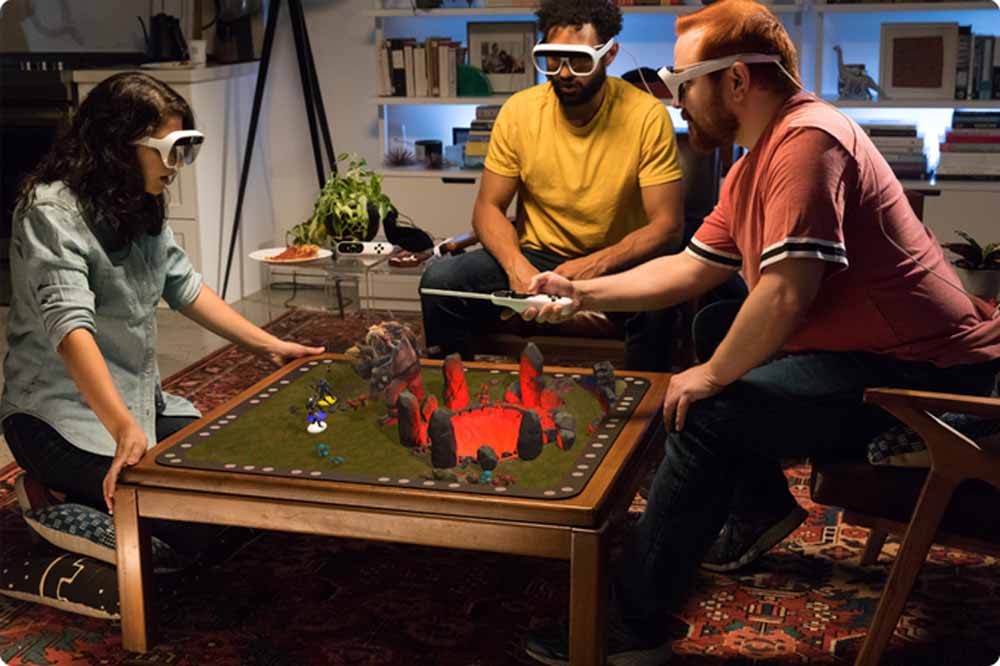Tilt Five preview: Will augmented reality make it into living rooms?

At Gamescom 2022, I was able to take a look at the augmented reality board game system Tilt Five. Is it fun?
The exhibition halls at Gamescom 2022 quickly become a labyrinth. Between larger-than-life Bowser figures, a wrestling ring, and numerous colorfully decorated game booths, it's easy to lose track of what's going on.
During a brief orientation break in one of the crowded exhibition aisles, I find myself standing with my colleague Ben in front of an inconspicuous booth. Three empty white walls, two small tables, and a desk. In the otherwise colorful exhibition halls, this stand looked like a whiteboard.
Perhaps fitting, as the product on display there creates a vivid 3D world on an otherwise blank surface. We had found the booth of augmented reality company Tilt Five.
Ten years for a single piece of hardware - and it's finally ready for the market
We were greeted by Jeri Ellsworth herself. The former Valve engineer has been working on her augmented reality board game for the living room for almost ten years. A successful Kickstarter campaign ensured a budget of almost two million US dollars in 2019.
After pandemic delays, Tilt Five will go on sale with 16 AR games in the upcoming months. During Gamescom, the startup announced an AR hologram version of The Settlers of Catan. While we weren't able to play Catan, we managed to see an extensive technical demo designed to demonstrate the breadth of the AR system.
Tilt Five: What's left after the wow?
Ellsworth's enthusiasm for her heart's project, Tilt Five, is evident in every word. Every new game, every little game mechanic, she announces with shining eyes. Unfortunately, I can't always share her enthusiasm for her AR board game.
Yes, at first glance, Tilt Five is something special. Looking through the headset, I discover a three-dimensional landscape with trees, buildings, and a medieval fighter with only a white table with a shimmering silver overlay.
I can move freely around the table, oversee the playing field from above, or view the action up close. All without much loss of quality. Controlling the little hero via the stick controller works smoothly. I jump, run and swing the sword as if I were playing a top-view video game.
In fact, it feels exactly like that to me after just a few seconds - a simple video game. The resolution isn't particularly sharp, the graphics aren't particularly impressive, and the gameplay just doesn't feel like anything new. The 3D hologram wow effect fizzles out after a few moments.
Of course, this is the impression of someone who uses VR headsets and high-quality monitors daily. Those who have less experience with VR or video game graphics are probably more impressed. However, I can't imagine AR board games making their way into many living rooms.
There are niches where the system could be useful. For example, Tilt Five could be worthwhile for role-players and tabletop enthusiasts who have little space for their tables and figures. Assuming their D&D or Warhammer campaigns are adequately supported by the software.
And the system also has its strengths when traveling because it doesn't need much space: A table on the train is enough, and you can pass the time together with AR board games.
Enthusiast pricing
My biggest concern with Tilt Five, however, is the price. This doesn't seem to be the first time someone has raised the cost-benefit question, as I can tell from Ellsworth's response.
She argues content: there is new content all the time, she says, including third-party content. More licenses, such as Settlers of Catan, are to follow. In addition, the more glasses you buy, for example for the whole family, the cheaper the overall package becomes.
One Tilt Five headset costs $360. A package of three headsets costs $960. However, a leisurely round of board games is often even bigger. The initial cost then quickly exceeds the $1,000 mark. Those who want a larger board or a foldable version for the on-the-go pay extra.
Perhaps it would be more promising for Tilt Five to push deeper into the niche and bring tabletop classics like Warhammer into augmented reality with appropriate licenses, as described above. However, Ellsworth did not present us with a single true AR board game in the Gamescom demos.
Instead, I think the start-up is currently focusing too much on small action games that offer little more than mobile games on the smartphone.
However, one demo I liked very much: I was shown a human skull. The closer I got to it, the further into the brain I could see. With a little better resolution, Tilt Five could help schools, universities, or other teaching institutions illustrate lessons with this type of 3D hologram.
My first impression is that the content in particular needs to be improved for Tilt Five to be successful in the living room. Only then is it worth investing in several pairs of glasses.
Note: Links to online stores in articles can be so-called affiliate links. If you buy through this link, MIXED receives a commission from the provider. For you the price does not change.